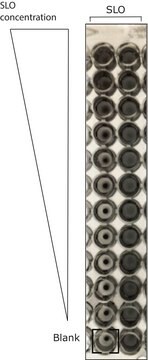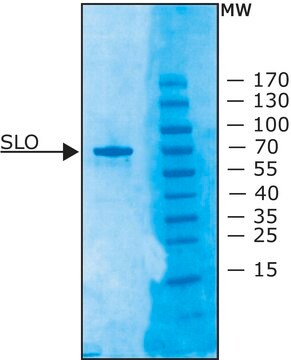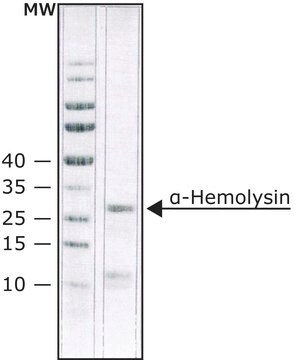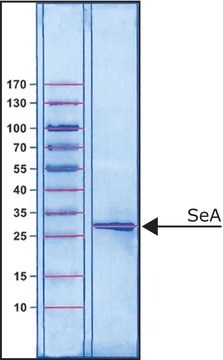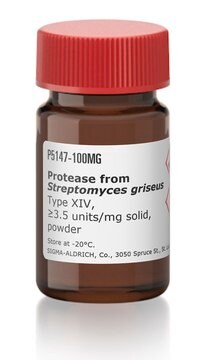T5319
Tetanolysin from Clostridium tetani
Anmeldenzur Ansicht organisationsspezifischer und vertraglich vereinbarter Preise
Alle Fotos(1)
About This Item
Empfohlene Produkte
Biologische Quelle
Clostridium tetani E88
Mol-Gew.
55 kDa
Anwendung(en)
cell analysis
Lagertemp.
2-8°C
Angaben zum Gen
Clostridium tetani E88 ... CTC01888(1060232)
Allgemeine Beschreibung
Hemolytic activity of tetanolysin is determined using 2.5% rabbit red blood cells at 37 °C for 40 min.
Anwendung
Tetanolysin has been used to analyze the formation of lytic pores in red blood cells (RBCs)1. It has also been used to permeabilize infected RBCs2.
Biochem./physiol. Wirkung
Cholesterol-binding toxin used to permeabilize cellular membranes to enhance the entry of macromolecules into the interior of the cell. Pores induced reported to be in the range of 20-50 nm.
Angaben zur Herstellung
Prepared by a modification of the method of Haque, et al.
Rekonstituierung
When reconstituted with 100 μl of sterile water the concentration is 1 μg/μl in 40 mM sodium phosphate buffer, pH 7.2, containing 200 mM NaCl.
Hinweis zur Analyse
Single band by SDS-PAGE.
Lagerklassenschlüssel
11 - Combustible Solids
WGK
WGK 3
Flammpunkt (°F)
Not applicable
Flammpunkt (°C)
Not applicable
Persönliche Schutzausrüstung
Eyeshields, Gloves, type N95 (US)
Analysenzertifikate (COA)
Suchen Sie nach Analysenzertifikate (COA), indem Sie die Lot-/Chargennummer des Produkts eingeben. Lot- und Chargennummern sind auf dem Produktetikett hinter den Wörtern ‘Lot’ oder ‘Batch’ (Lot oder Charge) zu finden.
Besitzen Sie dieses Produkt bereits?
In der Dokumentenbibliothek finden Sie die Dokumentation zu den Produkten, die Sie kürzlich erworben haben.
Hayley E Bullen et al.
The Journal of biological chemistry, 287(11), 7871-7884 (2012-01-19)
To survive within its host erythrocyte, Plasmodium falciparum must export hundreds of proteins across both its parasite plasma membrane and surrounding parasitophorous vacuole membrane, most of which are likely to use a protein complex known as PTEX (Plasmodium translocon of
Jason W Rosch et al.
The Journal of clinical investigation, 120(2), 627-635 (2010-01-23)
Sickle cell disease (SCD) is characterized by intravascular hemolysis and inflammation coupled to a 400-fold greater incidence of invasive pneumococcal infection resulting in fulminant, lethal pneumococcal sepsis. Mechanistically, invasive infection is facilitated by a proinflammatory state that enhances receptor-mediated endocytosis
Unser Team von Wissenschaftlern verfügt über Erfahrung in allen Forschungsbereichen einschließlich Life Science, Materialwissenschaften, chemischer Synthese, Chromatographie, Analytik und vielen mehr..
Setzen Sie sich mit dem technischen Dienst in Verbindung.